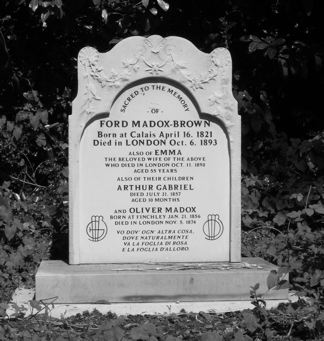Ford Madox Brown

Ford Madox Brown's gravestone c.1994 –
the hyphen in his surname is a mistake by the mason.
Many of those buried in East Finchley's cemeteries had few links with this area, but one of the best-known residents of St Pancras & Islington Cemetery – the painter Ford Madox Brown – did in fact live nearby for an important period in his life.
Brown, the son of a retired Royal Navy purser, was born in 1821 in Calais, and studied art in Bruges, Ghent and Antwerp. After working in Paris for a while, a competition to produce murals for the new Houses of Parliament brought him to London. He won nothing in the 1845 competition, and moved on to Rome, for the health of his consumptive wife. (She died in May 1846 in Paris, as they were returning to England, and is buried in Highgate Cemetery.)
In August 1847 Brown was installed in a studio in Bloomsbury, and it was there in December 1848 that a new model came to pose for a picture of Cordelia at the Bedside of Lear.
By August 1853 that model, Emma Hill, had become his second wife, and they rented 1 Grove Villas, a new house (now demolished) fronting Ballards Lane in Finchley. This was a bad move professionally, as it tended to cut Brown off from potential West End customers, and an auction of his works designed to restore his finances the following July was a disaster.
He began to look for suitable landscape subjects. 'Out by 1/4 to 8 to examine the River Brent at Hendon, a mere brooklet running in most dainty sinuosity under overshadowing oaks and all manner of leafgrass,' he noted on 1 September 1854. 'Many beauties and hard to chuse amongst for I had determined to make a little picture of it.'
For the next few weeks he worked at The Brent at Hendon in the mornings, and in the afternoons on Carrying Corn, a harvest scene probably painted at nearby Grass Farm.
At the end of October, Brown was joined in Finchley by Dante Gabriel Rossetti, whom he had met in 1848 when Rossetti had approached him for lessons. Rossetti was painting a picture of a prostitute fainted by the roadside and found by her former lover, a young farmer, taking a calf to market. Where better to find a calf and cart as models than in rural Finchley? At Manor Farm, a mile from Grove Villas, in fact.
In January 1855 Brown's first son, Oliver, was born at Grove Villas.
Meanwhile, in the yard behind the house, Brown had resumed work on a picture that he had begun two years earlier, when his lack of success had led him to consider emigrating. The Last of England, as this was to be known, was finished in early autumn. On 3 September Brown loaded it on a handcart with five other pictures and took it to a West End room he had hired for a week. (He was in fact a pioneer of one-man art shows.) A dealer met him there and bought the picture for £150 – by far the highest price Brown had ever received.
A few weeks later, their lease up, Brown and his family moved to Kentish Town.
His reputation now steadily increased. As well as producing easel paintings, he became a member of William Morris's new firm of furniture designers, and he spent years working on a cycle of panels on the history of Manchester for that city's town hall.
He died, in 1893, in Fitzroy Square. But it was in Finchley that his luck had first begun to change.

Ford Madox Brown's gravestone as restored in 2014.
Teresa Newman and Ray Wilkinson, Ford Madox Brown and the Pre-Raphaelite Circle (London: Chatto & Windus, 1991)